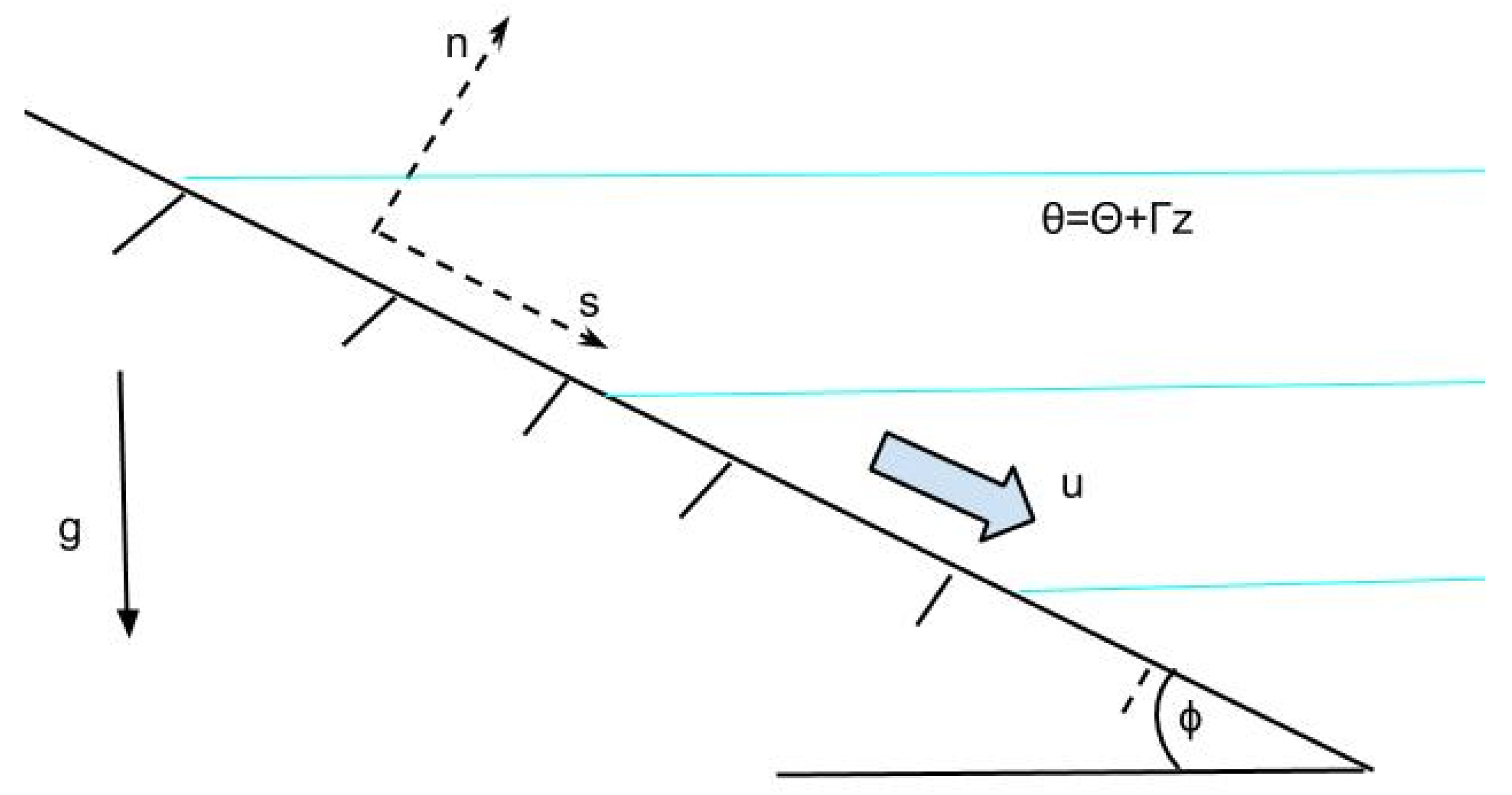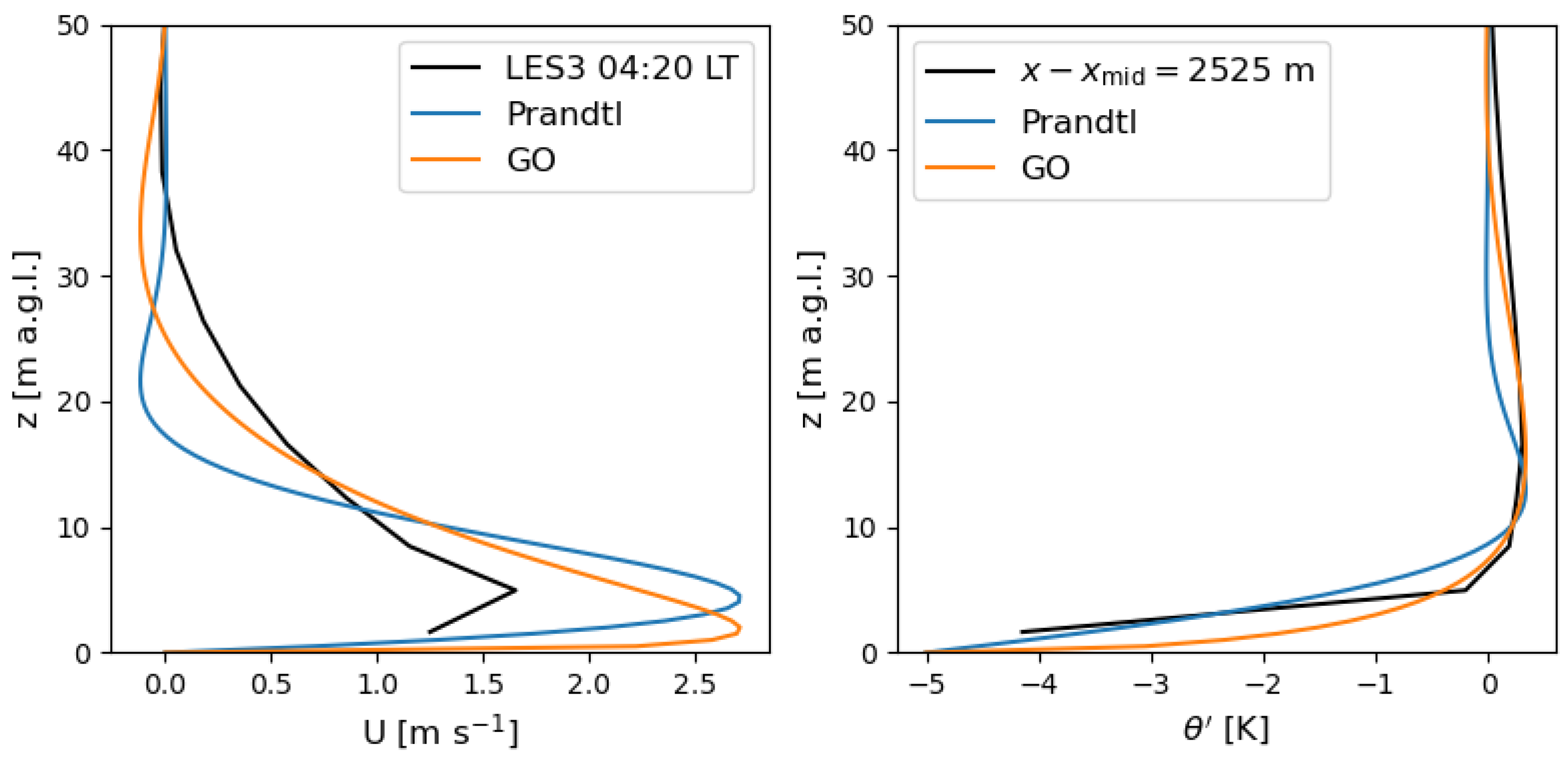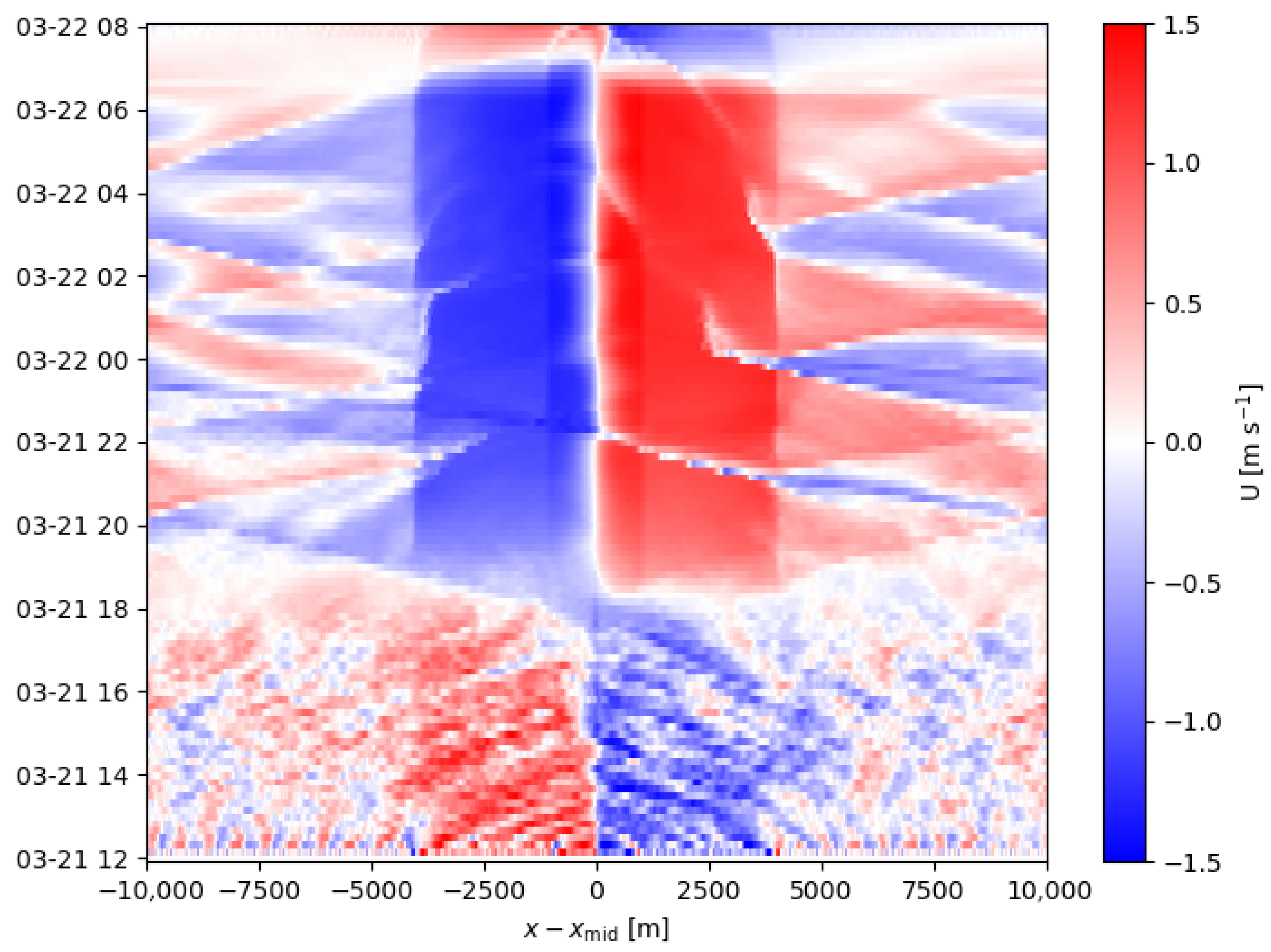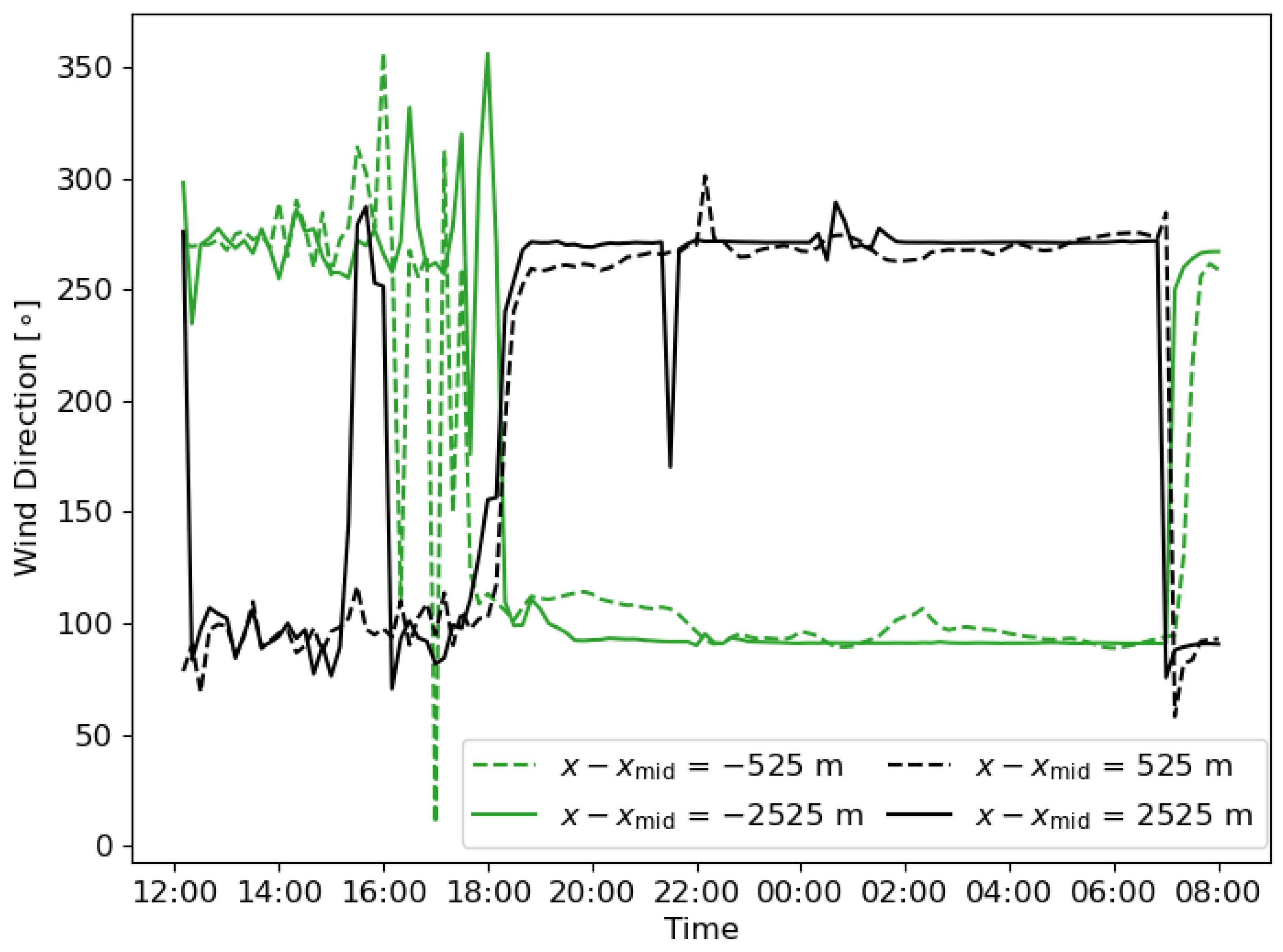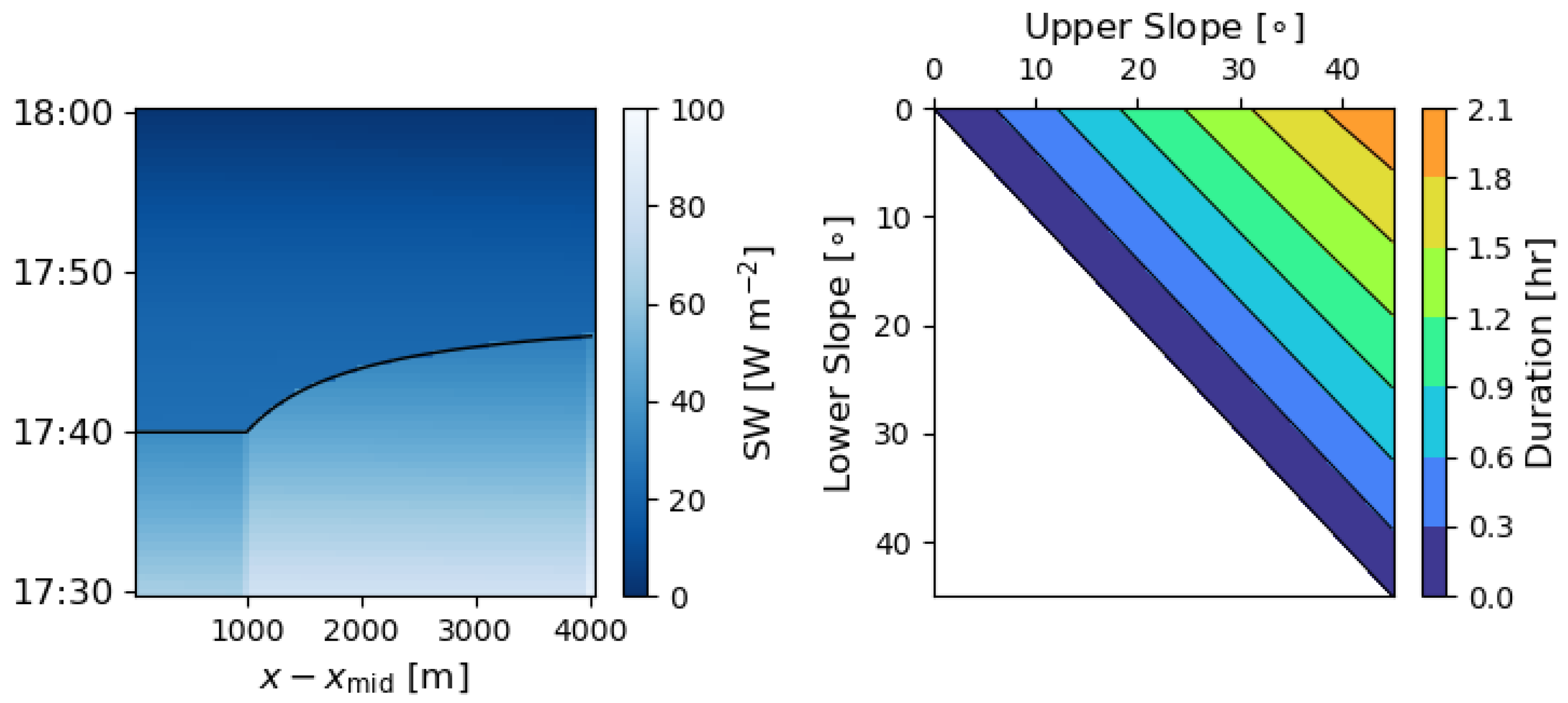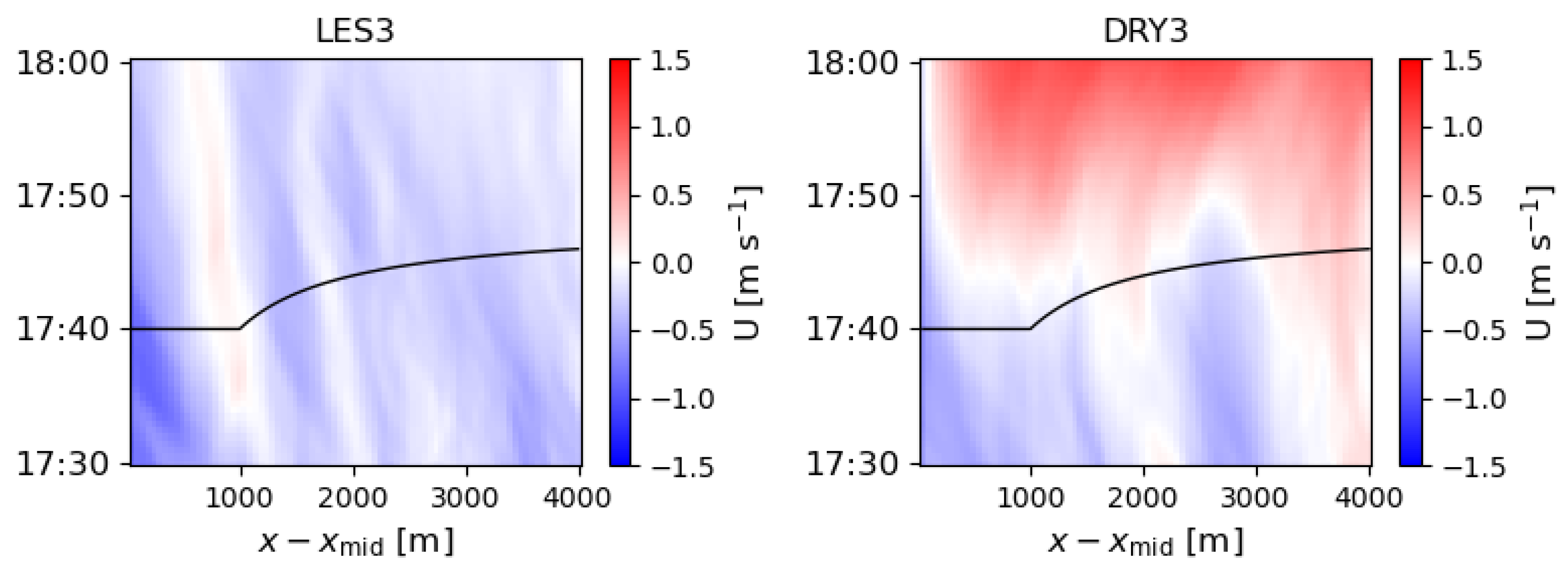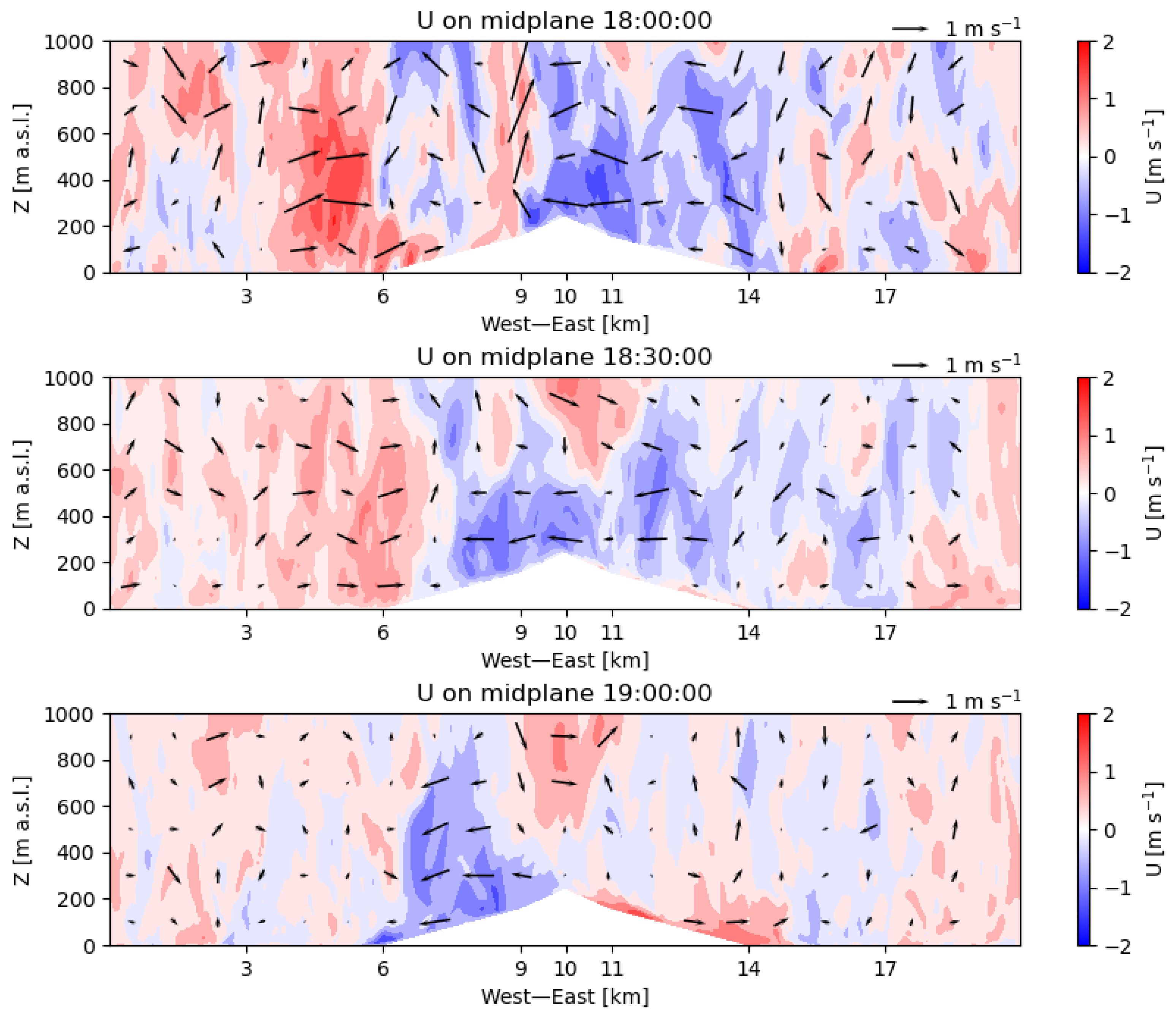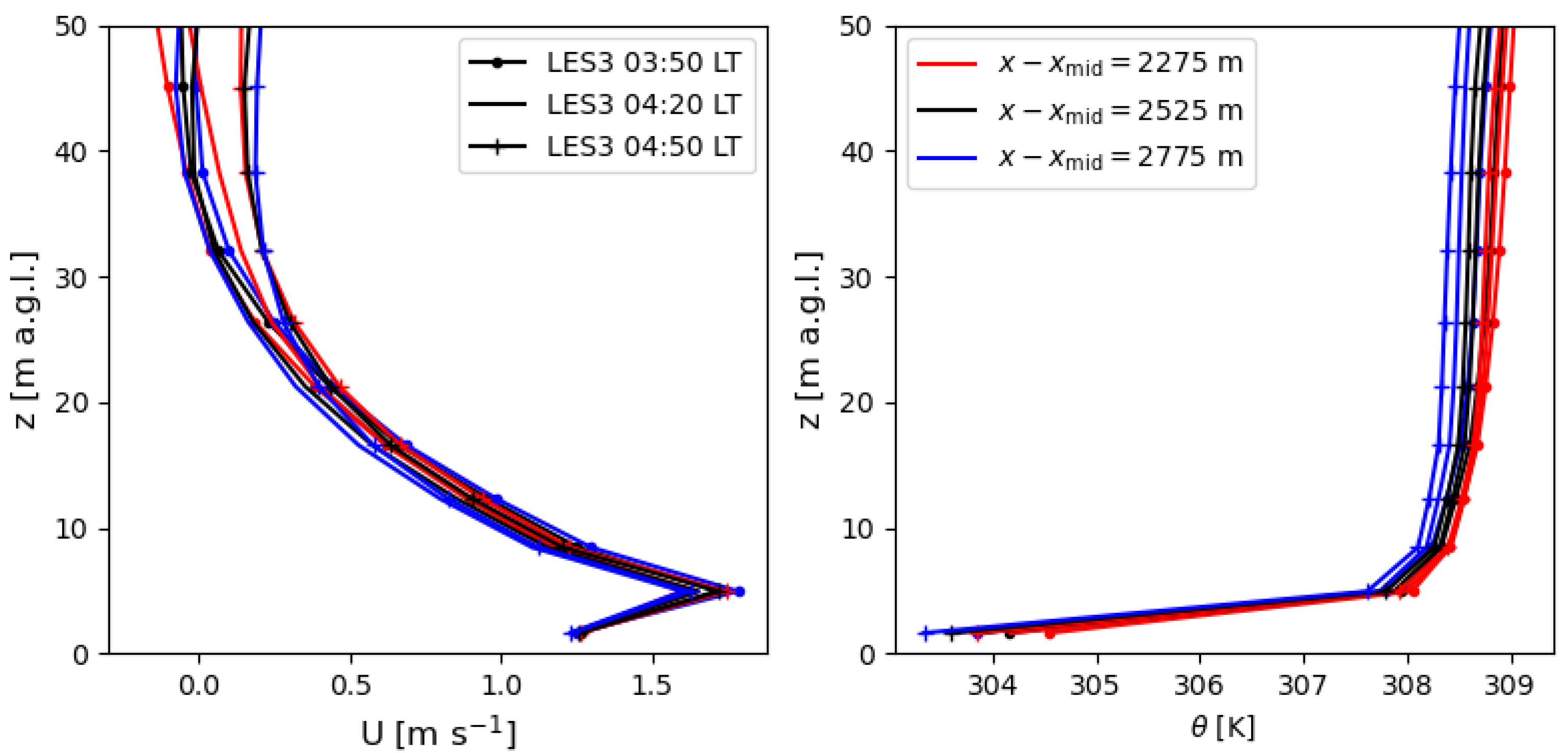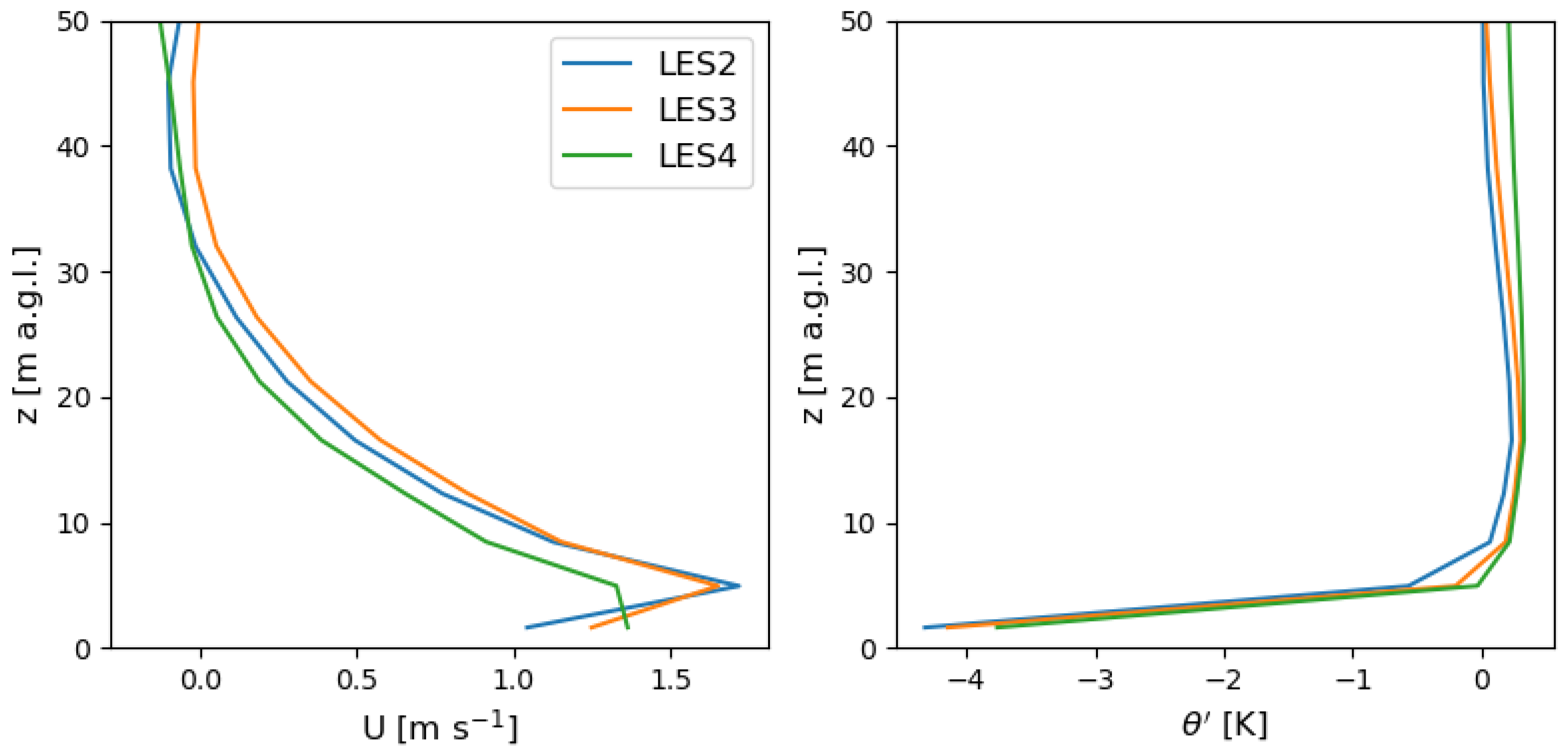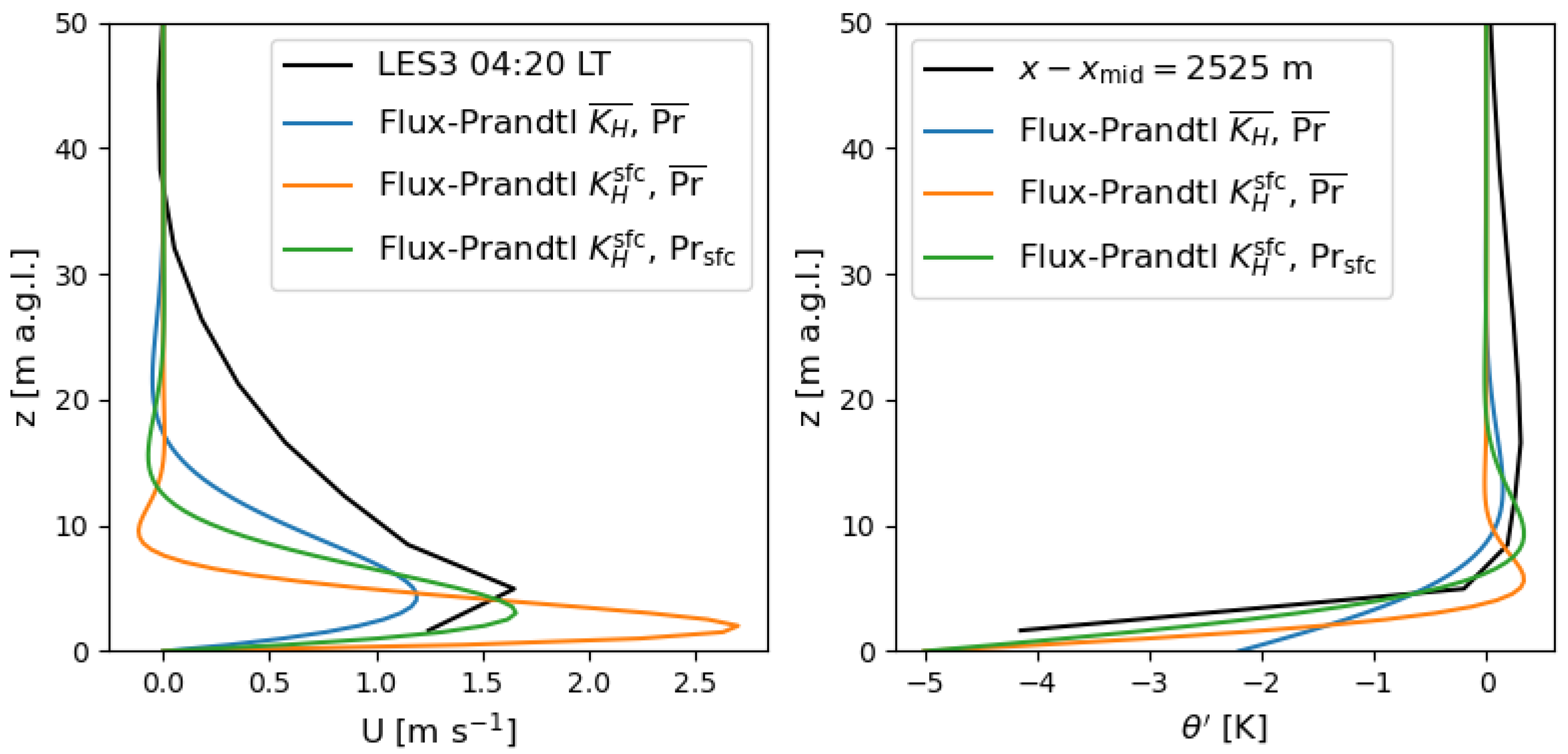4.1. Diurnal Cycle
The numerical model recreates the general pattern of the diurnal cycle that is predicted by fundamental theory [
34]—thermally driven flows that are upslope during the day and downslope during the night.
Figure 4 shows the time evolution of the along-slope (
x-direction) velocity from the lowest model half-level, ≈1.5 m a.g.l., averaged in the cross-slope (
y) direction.
Figure 5 shows the average wind direction from the middle of the four planes that piecewise define the shape of the terrain.
At the beginning of the simulation period (bottom of
Figure 4, left of
Figure 5), positively buoyant near-surface flows are most often upslope. This manifests as symmetry in the plots, so a sign change (
Figure 4) and a rotation by
(
Figure 5) are notable when comparing opposite sides of the mountain. Later, at around 18:00, these upslope flows begin to transition to downslope flows. This transition eventually occurs on both sides of the peak, but the broken symmetry near the centerline,
= 0, due to topographic shading is particularly notable around sunset, 18:00 LT, in the Hovmöller diagram (
Figure 4).
In addition to these changes in mean flow, after sunset, there are no sporadic periods of reversed flow, seen as small patches of different colors in
Figure 4 from just after initialization at 12:00 LT (bottom) until 18:00 LT, i.e., sunset. These cease because the levels of turbulence are suppressed during the nocturnal period after 18:00 LT until the end of the simulations at 08:00 LT (top). This is apparent in the time series of the wind direction as well, where the variability decreases significantly after the transition to downslope flows begins after 18:00 LT or sunset (
Figure 5). There are times of reversed flow (visible as thin red or blue streaks in the Hovmöller diagram), but these are due to the downslope flows from the opposite side of the mountain passing through the periodic boundary, as discussed in more detail below. Near the end of the simulation, around 07:00, the signs of the slope flow are again reversed as an upslope flow is initiated by the return to surface heating after sunrise.
4.2. Sunset
During the evening, a shadow is cast from the mountain peak onto the lower eastern slope. A line can be drawn from the sun to the peak of the mountain and extended to another point on this section of the eastern slope, as drawn in
Figure 3, which can be expressed in point-slope form as
where
is the solar angle.
The intersection of this line and the terrain represents the location of the shadow front as it moves down the slope. Solving the linear system for this point results in a function of the solar angle,
In general,
, where
is the latitude,
is the solar declination, and
is the hour angle. Considering the current choice to simulate the equator on the equinox, it follows that the solar angle is equivalent to the hour angle,
where
t is in hours. With this substitution and the application of a trigonometric identity for the inverse cotangent in Equation (
29), we arrive at
This form expresses the time of local sunset as the equinox sunset time, 18:00, and an offset due to the terrain. A special case of note, taking
, is also equal to the local sunset on the entire upper portion of the eastern slope, because the terrain line and the line traced back to the sun through the mountain peak are coincident for this case. With the slope angle expressed in radians,
The analytical solution for the shadow front given by Equations (
31) and (
32) agrees quite well with the model output, manifested by a quick decrease in shortwave radiation incident on the terrain (
Figure 6). The clear signal in radiation does not, however, translate to a clear signal in the
x-direction velocity during the same sunset time period (
Figure 7, left). While downslope flows eventually develop after sunset, the transition in LES3 (
Figure 4 and
Figure 5) is roughly an hour after the shadow completely encompasses the slope. Where a downslope flow is observed before sunset,
11 km, it appears attributable to subsidence associated with convective structures at
10.5 km and at 11.5 km (
Figure 8).
This differs from the experience of Arthur et al. [
10] in simulations of the onset of drainage flows with the real terrain of Granite Mountain, Utah. In their simulations, the onset of drainage flow was concurrent with—or, at some locations on the slope, even preceded—the shadow front. A possible reason for this discrepancy between the flow over the current ideal geometry and that in the real terrain used by Arthur et al. [
10] is the steeper slopes, ≈
at the peak and ≈
along the foothills of Granite Mountain. Further, this ≈
difference between the slopes at the Granite Mountain peak and its foothills is greater than the greatest difference,
, in the slopes considered here.
A consequence of this difference in slopes is the speed of the shadow front propagating along the lower slope. We can devise a metric for the duration of sunset as a function of the dimensionless group,
, using Equation (
31) and taking the difference in time for the shadow to reach
and
. This metric is plotted in the
–
parameter space in
Figure 6 (right), where the simulations presented here, with
and
, occupy the upper-left corner of this diagram, among the shortest durations. For Granite Mountain, we take
and
as approximate values and arrive at predicted durations that are roughly equal to the one-hour shadow front propagation independently reported in [
10].
These durations are most relevant in comparison to the timescales set by the thermal inertia of the land. We see that the land and soil characteristics are indeed important controls on this time lag given the more rapid onset seen in the DRY3 simulation. With drier soils, the transition to downslope flow occurs less than 10 min after the shadow front passes (
Figure 7, right), but nowhere does a downslope flow occur before the front passage, except where attributable to convection, as in LES3. The fact that drainage flows still follow the shadow front in these 2D simulations supports the hypothesis of Arthur et al. [
10], i.e., that the 3D terrain results in the early onset of a drainage flow at Granite Mountain. They argue that drainage flows can collect quickly in the narrow side valleys, which are shaded even earlier than predicted for the idealized geometry. The DRY3 simulation is missing these effects but has minimal thermal inertia. Apparently, even for longer sunset durations relative to the thermal inertia of the land, 3D effects are necessary for drainage flow onset to occur earlier than or concurrent with the shadow front.
4.3. Initial Development
An important physical process influencing the evening onset of drainage flows is daytime convection. Convective structures are shown in cross-sections of the vertical velocity taken shortly before and after the shadow front propagates along the eastern slope (
Figure 8). We see that, although weakened after sunset, the same convective systems are present in similar locations as before sunset. The timescales related to the persistence of these convective structures are likely to be only weakly dependent on the slopes of the terrain but will depend strongly on the land and soil properties. Future work is needed to more systematically investigate the dependencies on the land and soil characteristics of these timescales that arise from a balance between the thermal inertia of the land surface, subject to topographic shading, and the inertia of lingering convective structures during the onset of drainage flow.
In the current simulations, the presence of convective structures post-sunset largely explains why the downslope flow initiates earlier on the sunnier western side than on the eastern slope. Because cooling by the surface boundary forces a drainage flow, this result may be counterintuitive. In
Figure 9, we see horizontal convergence on the western slope at 18:00 LT (top), associated with the strong updraft near
9 km, as also evident in the contours of the vertical velocity from the same time (
Figure 8). It is reasonable to expect that such convective updrafts more often persist on the western side of the mountain because this side receives insolation for longer than the shadowy eastern side. Over the next hour (
Figure 9, middle and bottom), the easterly portion of the convergent flow near the mountain peak enforces the downslope flow on the western slope, while opposing it on the eastern slope. Thus, earlier and stronger downslope flows can occur on the side that receives insolation later in the evening.
The findings at 19:30 LT, shown in
Figure 10, show stronger, deeper downslope flows than are expected from buoyancy forcing alone. These initial downslope flows may be distinguished as “plunging” flows rather than “drainage” flows. Shallower drainage flows can be distinguished by 21:30, in the wakes of the plunging flows on the western slope and, on the eastern slope, colliding with the front of the easterly plunging flow, which has since passed through the periodic boundary. By 23:00, this air mass reaches the peak of the mountain, while its counterpart, the westerly plunging flow, lags behind but has similarly intruded through the periodic boundary, with its front just reaching the base of the foothills at
6 km.
Similar intrusions repeat throughout the night, although the LESs were designed with substantial flat plains abutting the mountain slopes so that this would not occur. As such, these intrusions are arguably a shortcoming of the model. Instead of standalone simulations with periodic boundary conditions, a nested approach would address this shortcoming. A limitation of such a nested LES is the absence of resolved turbulence at the inflow from the parent mesoscale domain. With new methods for seeding turbulence tested for complex terrain cases in the WRF model [
35], future work may prefer to use a nested LES strategy.
Here, our recourse is the realization that rarely do mountains exist in such isolation, so intrusions due to flows from neighboring terrain might be more typical than atypical for these wind systems. We may then decide that our model problem is most applicable to the geometry of rolling mountains or hills rather than to isolated peaks. Whether we consider these artificial or fundamental, the intrusions eventually become weak enough to study the steady-state structure of the drainage flow, as we do in the following section.
4.4. Fully Developed, Steady Drainage Flow
Although the initial stages of downslope flow development are complicated by both persistent convective structures and neighboring terrain, the drainage flows in the later stages of the nocturnal period are quite comparable to the steady-state, analytical solutions presented earlier (
Section 2). For at least an hour, from 03:50 until 04:50, the velocity and potential temperature profiles show a steady state at the middle of the shallower eastern slope, as shown in
Figure 11. During this time, the profiles of the velocity vary only slightly over 500 m, a sixth of the total slope length, centered at the middle of the slope (
Figure 11). When comparing the profiles of the potential temperature, recall that the analytical solutions predict potential temperature perturbations, while the profiles in
Figure 11 are of the potential temperature itself. The differences between the full temperature are consistent with stable background conditions: air farther up the slope (lower
x) is warmer than lower on the slope, albeit only slightly given the shallow slopes considered here. As these profiles are similar but for a roughly constant shift, the perturbations are equal. Over the range of distances shown, the flow is therefore approximately fully developed. This time, i.e., 04:20, and this location, i.e., the middle of the shadow slope, are selected for comparisons to analytical solutions and for the investigation into the dependence on the terrain slope—a parameter that we vary for numerical experimentation.
The parameters of the analytical solutions are extracted from the LES by various means of approximation. While a rough estimate of the temperature perturbation at the surface,
, is relatively easy to obtain from these mean profiles, other parameters are more challenging to estimate. One challenge is that the lapse rate,
, is not constant and has a more physically realistic profile in which stronger stability is observed nearer the surface of the plains than it is farther up the foothills (
Figure 12). This feature is in part due to the drainage flows themselves, so the figure shows some differences between the LESs with varied slopes. The fact that there is no clear separation of scale between the background and slope environment exemplifies one way that the current LES is more sophisticated than previous models. It also complicates comparisons controlling for parameters other than slope in the semi-ideal setting. Despite slight differences between models, we find that approximate values from LES3, our middle slope scenario, can be applied to the other LESs, as well as being used as the parameters for the analytical solutions. From the height corresponding to the base of the steady-state profile, the LES3 results show a domain-averaged potential temperature increase of 1.5 K over 100 m. This provides a value for the background lapse rate, although no dichotomy between the background and slope environment exists in the LES. The reference temperature is similarly determined from the mean simulated temperatures (
Figure 11). The parameters extracted from the LES that are used in the analytical solutions, as applicable, are
We estimate additional constant diffusivities
to compare with the Prandtl solution, as previously shown in
Figure 2, from the LES results (
Figure 13). In the LES,
and
are computed by the TKE 1.5-order turbulence closure [
23,
24] in WRF and vary in height. The Grisogono and Oerlemans solution allows for height variation but requires the specification of functional forms restricted by the additional requirement of a constant Prandtl number. We use the same functional form as Grisogono and Oerlemans [
9] given by Equation (
26), and tune the parameters below to match profiles from WRF,
to plot the GO solution in
Figure 2.
Surprisingly, although the diffusivity profiles used in the GO solution are quite similar to those predicted by the LES (
Figure 13), it is not clear to which existing analytical solution the LES compares better (
Figure 2). This is particularly true with regard to the height and magnitude of the velocity maximum, which occurs at approximately 5 m in the LES and Prandtl models but only about 2.5 m in the GO solution. Some of this discrepancy, however, is due to the vertical resolution in the WRF simulations, which are limited over sloped terrain [
4,
5] by
This is the height of the first model half-level in our simulations. As such, the vertical resolution cannot be further refined without refining the horizontal resolution and time step, which can quickly become prohibitively expensive. The simulated wind maximum is lower magnitude than predicted by either of the analytical solutions, which are in rough agreement with each other. Farther above the jet maximum, the benefits of the variable diffusivity are apparent by the more gradual relaxation to quiescent winds, a notable feature of the LES profiles as well.
With full atmosphere and land physics, as represented by a state-of-the-art NWP parameterization suite, constant surface forcing is not a user-designated control on the flow, as in many previous LESs of drainage flows. Especially in this setting, it is not clear that a steady-state flow would fully develop over the finite slopes and finite nocturnal period simulated. Nonetheless, the LESs predict shallow jets of drainage flows. As such, even in these realistic settings, the simpler analytical work remains relevant. However, room for improvement in the analytical approach is also evident. Before undertaking model development, we present new evidence for a functional dependency on the slope angle provided by numerical experimentation in WRF-LES.
4.5. Dependence on Slope
Although steeper slopes further tilt the buoyancy force vector into the along-slope direction, a more rapid decline into colder air reduces the magnitude of the buoyant force, which tends to slow the flow. Indeed, previous modeling studies of drainage flows over valley and glacier walls show that the maximum velocity,
, decreases with greater slope angles [
12]. This was validated indirectly through observation [
11], but, in the classic Prandtl model, only the height of the velocity maximum decreases,
, while the magnitude is independent of the slope angle. Previous LESs corroborated
but found
in one study [
11] and
in another [
12,
18]. Neither of these studies used LES coupled with advanced surface or soil parameterizations, such as those available in WRF. Importantly, even when momentum fluxes were evaluated via Monin–Obukhov similarity theory [
26], either constant surface cooling or constant buoyancy fluxes (analogous to heat flux) were prescribed in previous work.
The WRF model uses a fully coupled Noah land surface model and a surface-layer scheme to jointly evaluate the fluxes of both momentum and heat, so it is worthwhile to investigate the dependence on terrain slope through the comparison of LES2, LES3, and LES4, which represent slope angles of
,
, and
, respectively. Complicating this effort to isolate the direct influence of the slope angle are a number of secondary effects that respond to changes in slope. Although the radiative fluxes, which dominate the regional energy balance, are only slightly altered in this small range of angles, from two degrees to four degrees, the presence of the drainage flows themselves affects the background thermal structure (
Figure 12). Nonetheless, the same lapse rate used in the analytical models does well to remove the background in the potential temperature profiles shown in
Figure 14 for all of the LESs compared. However, we reduce the potential temperature to its perturbation by subtracting a reference that is 0.25 K lower for LES2 than the
of 308 K found in the other LESs.
The velocity profiles in the current LES show that the velocity maximum decreases with increasing slope angles (
Figure 14), as in more idealized LESs [
11,
12,
18]. Here, the relatively coarse vertical resolution and sparse coverage of incline angles preclude a meaningful statistical fit to
, especially for the height of the jet maximum. Qualitatively, we can determine that the current LESs agree with the previous LESs in that the highest slope angles result in the shallowest jets. For a more satisfactory description of the vertical structure, future work may iterate on the estimates of the jet height shown here to act on the advice of Smith and Porté-Agel [
7] to improve LES by placing additional grid levels below the jet height.
4.6. The Flux–Prandtl Solution
The lack of dependence of the wind maximum on the slope angle is a much discussed discrepancy between Prandtl’s analytical model and simulations [
11,
18]. In the same physical setting as Prandtl, we present a new analytical solution that explains this.
To derive this Flux–Prandtl solution, we retain all the assumptions of Prandtl, including that of constant eddy diffusivities (
Section 2.1). Instead of a constant temperature deficiency, we assign a constant temperature flux,
, at the bottom surface as a Neumann boundary condition:
For this system (Equations (
3) and (
4)), subject to these new boundary conditions, the solution is based on the complex exponential,
, given in Equation (
13):
where
In this abbreviated form, it is easiest to see that the Prandtl solution can be recovered with the substitution
With constant diffusivities, as in the original Prandtl model, the dependency on the slope of the height of the wind maximum is unchanged with a heat flux boundary condition. However, in this case, the magnitude of the wind velocity maximum inherits the same dependency on the slope from
for
Holding other parameters constant,
does decrease over steeper slopes when replacing the Dirichlet boundary conditions with Neumann boundary conditions in the original Prandtl model. The fact that previous LES used boundary conditions that were more similar to these flux conditions explains the discrepancy with the Prandtl model, but only when enforcing Dirichlet conditions. With surface heat flux applied as a Neumann boundary condition, the Prandtl model recreates the same power law found by a previous numerical experiment [
11], which is qualitatively similar to others [
18], including the current, in which the velocity maximum decreases with increasing slope angles (
Figure 14).
As with the other parameters, we take the surface heat flux,
= −0.008 K m
, from WRF-LES. However, the resulting solutions in
Figure 15 (blue) improve the agreement only in the velocity, while severely underestimating the temperature deficit at the surface. We can instead choose to parameter-fit both the temperature flux at the surface and the perturbation itself there. From Equation (
49), we define an effective eddy diffusivity at the surface,
In such a case, the dependency on the slope is altered,
while the agreement with the temperature perturbation at the surface is much improved (
Figure 15, orange and green).
With comparable Prandtl numbers, the effective surface diffusivity is about an order of magnitude lower than those used previously to characterize full profiles from the LES (
Figure 13). As in the GO solution with Pr = 0.75 (
Figure 2), which had the diffusivities approach zero at the surface, the newly predicted jet (
Figure 15, orange) is lower and its magnitude increased. This is a consequence of fitting the diffusivities to the surface but not adjusting the Prandtl number. We note that, in WRF (
Figure 13), not only do the diffusivities decrease near the surface but the Prandtl number increases. This is consistent with a known dependency of the turbulent Prandtl number on density stratification, typically as a function of the Richardson number for stable cases [
36]. As the near-surface temperature gradients here are large, we may expect a larger Prandtl number,
= 2, to better represent this strongly stable surface layer. When we adjust both these parameters (
Figure 15, green), the velocity maximum agrees better and the height of the jet returns to roughly that of the LES. However, although the jet deepens, it remains relatively symmetric compared to GO or LES, because the diffusivities are held constant at a low surface value, which inhibits mixing momentum farther above the jet height.
4.7. The Flux–GO Solution
The parameters for the diffusivity profiles used in the GO solution given by Equation (
26) were selected based on comparisons to those from LES3 (
Figure 13). Instead, we may abandon this fidelity approach and choose to define an effective eddy diffusivity that will take non-zero values at the surface, such that solutions fit to surface flux values may be physically consistent. We blend the two with a relatively simple combination
with
and we plot in
Figure 16 the Flux–GO solutions as
which, as with the Flux–Prandtl cases, agrees with LES best when the turbulent Prandtl number is increased to reflect the near-surface values. In this case, the magnitude and height of the jet are well approximated, and the more gradual relaxation to quiescent winds is also represented.
The need for a non-zero diffusivity at the surface naturally extends to this effective diffusivity approach, but the impact of a non-constant Prandtl number is not addressed. Although the LES resolves variations in the Prandtl number (
Figure 13), we have selected an even larger Prandtl number to more dramatically demonstrate the effect of the Prandtl number on the shape of the profile. We argue that this represents the unresolved surface layer, so this choice unsurprisingly leads to improved agreement at and below the jet height. However, disagreement above jet heights where the Prandtl number is less representative remains. We understand this to be a consequence of larger diffusivities, which are a function of the Prandtl number (Equation (
52)). In the velocity profiles, this is a benefit because the WRF profiles also exhibit more gradual relaxation to quiescent winds. In the temperature profiles, however, the gradual relaxation to a reference temperature is less physical. We did not attempt to optimize our combination of the diffusivities at the surface,
, and above,
, from the GO solution. For instance, specifying the fraction,
a, in Equation (
55) as a function of Pr to counteract the Pr dependence in Equation (
52) could further improve the agreement of the Flux–GO solution with the LES. However, because this thermal diffusivity does not decrease relative to the momentum, the relatively sharp gradients in temperature appear irreconcilable with the gradual relaxation to quiescent winds in lieu of a variable Prandtl number.
Further extension of the current analytical model could revisit the WKB method and instead take Pr as the parameter that varies the momentum diffusivities relative to a fixed heat diffusivity, fit to the surface flux values. Alternatively, absorbing the Prandtl number dependence into integrals analogous to those in Equation (
20) may account for the joint variability in eddy diffusivities and their ratio, the turbulent Prandtl number. More tangentially, a momentum surface flux can be enforced with the same governing equations, similarly to the surface heat flux considered here. Such analytical work should be encouraged by the agreement with LES achieved through the model developments presented here.
